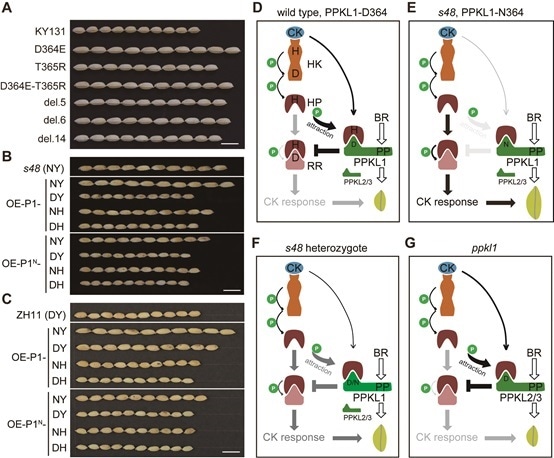The classical historic plant hormones, cytokinins, regulate different aspects of plant growth and development. These include crucial agronomic traits like grain number in rice.

Molecular design of rice grain size via manipulation of the cytokinin signaling controller PPKL1. Image Credit: Institute of Genetics and Developmental Biology.
The canonical signal transduction process of cytokinins is famously known as the phosphorelay process—which implies the transfer of the phosphoryl group to various proteins including histidine receptor kinases (HKs), histidine phosphotransfer proteins (HPs), and responsive regulators (RRs). Yet, it is still unknown whether this mechanism is regulated by plant cells and whether the hormones control grain size in rice.
Scientists from the Institute of Genetics and Developmental Biology of the Chinese Academy of Sciences (CAS) recorded a novel cytokinin signaling component, called PPKL1, that functions by seducing the phosphoryl group to interfere with the hormonal signaling thus suppressing grain size in rice. The study was published in the Molecular Plant journal.
The observations highlight the need for a specific amino acid D364 of PPKL1 (Protein Phosphatase with Kelch-like domains) for protein function. This specific amino acid D364 is found in a region resembling the receiver domain of RRs.
Similar to RRs, PPKL1 is capable of interacting with OsAHP2, one of the authentic HPs. Consequently, PPKL1 can utilize D364 to suppress OsAHP2-to-RRs phosphorelay, whereas mutation of D364 eliminates the impact, thereby activating cytokinin response and enlarging grain size.
PPKL1 was earlier known as a signaling component of the steroid hormone brassinosteroid. The current research demonstrated that it is a cryptic inhibitor of cytokinin phosphorelay. The study also revealed that this function is independent of the phosphatase domain that is needed for brassinosteroid signaling.
The editing of the D364-residential region results in numerous semi-dominant mutations linked with diversely increased grain sizes. Their screening allowed the detection of two genotypes, providing enhanced grain yield.
Professor Hongning Tong, the chief scientist of the group, remarks that to fulfill the demand for food owing to the increasing population, severe efforts are undertaken to comprehend the regulation of cellular growth in cereal grains, the staple food source.
The current research unravels a noncanonical cytokinin signaling suppressor along with an advanced tool for seed rational design. Thus, the current research drives advancement in both basic and applied research works.
Source:
Journal reference:
Liu, D., et al. (2021) A Cryptic Inhibitor of Cytokinin Phosphorelay Controls Rice Grain Size. Molecular Plant. doi.org/10.1016/j.molp.2021.09.010.